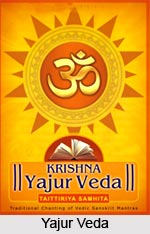 Origin of Brahmanas can be traced back to a number of Sakhas or schools. A number Brahmanas have existed in conjugation with a Vedic text. Of this it is confirmed by the many quotations from lost Brahmanas, very few have survived. However the number of even those Brahmanas which are still preserved is by no means small, and moreover, all of them, should be classed among the mote extensive works of Indian literature.
Origin of Brahmanas can be traced back to a number of Sakhas or schools. A number Brahmanas have existed in conjugation with a Vedic text. Of this it is confirmed by the many quotations from lost Brahmanas, very few have survived. However the number of even those Brahmanas which are still preserved is by no means small, and moreover, all of them, should be classed among the mote extensive works of Indian literature.
According to the four Vedic Samhitas, the four Vedas were distinguished, and to each of the latter several Brahmanas usually belong, which issued from various schools (Sakhas). The Samhitas of the Black Yajur Veda already contained, besides the mantras or prayers, also declarations of opinions and discussions on the purpose and meaning of the sacrifice. In these Brahmana-like parts of the Yajur Veda Samhitas is seen the beginning of the Brahmana literature. It was these very directions for the performance of the sacrificial ceremonies and the discussions on the meaning of the ritual, which in the Samhitas of the Black Yajur Veda were directly connected with the Mantras themselves, it was just these which one Vedic school after another made the subject of individual works. Soon it was regarded as a rule that every Vedic school must possess a Brahmana.
This explains on the one hand the large number of Brahmanas, and on the other hand the circumstance that some works were designated as Brahmanas, which deserve this name neither for their contents nor for their extent, and which belong to the latest productions of Vedic literature. Of this type are many so-called `Brahmanas` of the Sama Veda, which are nothing but Vedangas, and also the Gopath-Brahmana of the Atharva Veda. The latter is of the latest works of the whole of Vedic literature. There was no Brahmana at all belonging to the Atharva Veda in early times. It was not until a later period, when a Veda without a Brahmana could not be imagined, that an attempt was made to fill this gap.
This then is how the different Brahmanas of the Vedas originated.



















